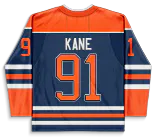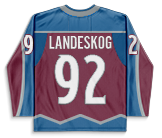Alexeyev exited Game 1 on Monday due to an upper-body injury after playing only 14:02 time-on-ice. The 25-year-old defenseman only played eight games this season, scoring zero points. He will be able to return to the lineup for Game 2 on Wednesday.

Alexeyev exited Game 1 on Monday due to an upper-body injury after playing only 14:02 time-on-ice. The 25-year-old defenseman only played eight games this season, scoring zero points. He will be able to return to the lineup for Game 2 on Wednesday.

Protas missed the final six games of the regular season and will now miss the first two games of the playoffs due to a laceration on his foot, but appears to be nearing a return to the lineup as he was a game-time decision on Wednesday. The 24-year-old Protas scored an impressive 66 points (30G / 36A) in 76 games this season.

Klingberg has not played since March 27th and has only played 11 games this season, scoring four points (1G / 3A), but will return to the lineup for Game 2 on Wednesday. The 32-year-old Klingberg has only played 11 playoff games in the previous five seasons but has been a proven performer, scoring 39 points (8G / 31A) in 63 career contests. Josh Brown will exit Edmonton's lineup to accommodate Klingberg's return.

Kane has spent the entirety of the 2024-25 season recovering from abdominal surgery but will make his return to the lineup in Game 2 on Wednesday. The 33-year-old Kane has spent the previous three seasons with the Oilers, tallying 111 points (62G / 49A) in 161 games. Jeff Skinner will exit the lineup to accommodate Kane's return.

Cirelli exited Tuesday's 6-2 Game 1 loss to the Florida Panthers after playing only 6:21 time-on-ice due to an undisclosed injury. Nick Paul centered Tampa Bay's second line after Cirelli's injury. The 27-year-old Cirelli scored a career-high 59 points (27G / 32A) in 80 games this season.

Ehlers has only played twice in the last three weeks and will await his 2024-25 playoff debut, not travelling with the Jets to St. Louis for Game 3. As they are with Gabriel Vilardi (upper body), the Jets are taking a cautious approach with returning two integral offensive pieces to their lineup with a comfortable 2-0 lead over the Blues. The 29-year-old Ehlers scored 63 points (24G / 39A) in 63 games this season.

Up 2-0 in the first-round series against the St. Louis Blues, the Jets are taking a cautious approach with returning Vilardi to the lineup. Vilardi appears to be nearing a return but without a rush to insert him into to the lineup, the Jets will likely wait until Vilardi returns to 100% health before proceeding with full-contact practices. The 25-year-old Vilardi was having a tremendous season for the Jets before his injury, scoring 61 points (27G / 34A) in 71 games.

Protas missed the final six games of the regular season and missed Game 1, but could return to the lineup for Game 2. The 24-year-old Protas scored an impressive 66 points (30G / 36A) in 76 games this season.

Alexeyev exited Game 1 on Monday due to an upper-body injury after playing only 14:02 time-on-ice. The 25-year-old defenseman only played eight gams this season, scoring zero points. He could be ready to return to the lineup for Game 2 on Wednesday.

Landeskog participated in the pregame skate on Monday but was a late scratch, delaying his return to the lineup. He has not played in an NHL game since the 2021-22 season, but appeared in two AHL games during a conditioning loan this month. The Avalanche did not confirm that he would play, but implied a realistic chance that he returns to the lineup on Wednesday for Game 3.

Tkachuk suffered a lower-body injury as a member of USA's team in the 4-Nations Face Off and has not played since. After practicing with the Panthers the last several days, he appears set to return to the lineup for Game 1 against the Tampa Bay Lightning. The 27-year-old Tkachuk scored 57 points (22G / 35A) in 52 games this season.

Tkachuk suffered a lower-body injury as a member of USA's team in the 4-Nations Face Off and has not played since. That said, he has been practicing with the Panthers the last several days and could return to the lineup for Game 1 against the Tampa Bay Lightning. The 27-year-old Tkachuk scored 57 points (22G / 35A) in 52 games this season.

Kane has spent the entirety of the 2024-25 season recovering from abdominal surgery but could make his return to the lineup in Game 2 on Wednesday. The 33-year-old Kane has spent the previous three seasons with the Oilers, tallying 111 points (62G / 49A) in 161 games.

Klingberg has not played since March 27th and has only played 11 games this season, scoring four points (1G / 3A), but could return to the lineup for Game 2 on Wednesday. The 32-year-old Klingberg has only played 11 playoff games in the previous five seasons but has been a proven performer, scoring 39 points (8G / 31A) in 63 career contests.

Robertson was injured in the final game of the season, and remains out of the lineup, week-to-week, without further update. Given the uncertainty and lack of updates around Robertson's injury, it would be surprising to see him return in the first round of the playoffs. The 25-year-old forward had 80 points (35G / 45A) in 82 games this season.

Heiskanen has practiced in a non-contact jersey the past few days and will travel to Colorado with the Stars. The tight first-round matchup is tied 1-1 with Game 3 on Wednesday, followed by a two-day break before Game 4 on Saturday. Heiskanen scored 25 points (5G / 20A) in 50 games and would provide a huge lift for a Stars team that struggled defensively down the stretch.

Up 2-0 in the first-round series against the St. Louis Blues, the Jets likely will not insert Vilardi into the lineup until he is fully healed. Given his up-in-the-air status for Game 3, Vilardi's health is likely near perfect as his return to the lineup seems to be on the imminent horizon. The 25-year-old Vilardi was having a tremendous season for the Jets before his injury, scoring 61 points (27G / 34A) in 71 games.

Tkachuk suffered a lower-body injury as a member of USA's team in the 4-Nations Face Off and has not played since. That said, he has been practicing with the Panthers the last several days and could return to the lineup for Game 1 against the Tampa Bay Lightning. The 27-year-old Tkachuk scored 57 points (22G / 35A) in 52 games this season.

Greig played 17:51 time-on-ice and scored a goal in his playoff debut on Sunday but is nursing an undisclosed ailment that kept him from skating on Tuesday morning. Still, he is expected to be an option for Game 2 against the Toronto Maple Leafs. The 22-year-old Greig had 34 points (13G / 21A) in 78 games this season.

Alexeyev exited Game 1 on Monday due to an upper-body injury after playing only 14:02 time-on-ice. The 25-year-old defenseman only played eight gams this season, scoring zero points. He is expected to be ready to return to the lineup for Game 2 on Wednesday.

The NHL injury report is updated daily so that you can see the latest injury news ahead of puck drop in any of today’s matchups. Seeing timely updates to the NHL injury report can make a major impact on your daily fantasy sports picks and wagers on a particular game. All information provided on the NHL injury report is provided directly by the NHL and each respective franchise to ensure accuracy.
While the minimum amount of time spent on the injured reserve list is seven calendar days, there is no maximum amount of time that a player can be placed on the injured reserve list. If a player is set to be sidelined for longer than 24 calendar days or 10 NHL games, then a club may opt to place them on the long-term injured reserve instead. This allows franchises with the ability to exceed the salary cap while a player is placed on this reserve list.
No injury recovery timeline is the same as another as there are several factors that go into the rehab process for a player being affected by injury. Factors include but are not limited to, injury severity, player injury/medical history, age, as well as the location of the injury. Some injuries are able to clear up in a matter of days, while others may take an athlete out of action for the entirety of a season.